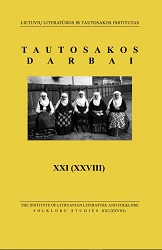«Басня» в составе Хронографа 1261 г. Фольклорный нарратив о Совии
The Baltic “Tale” in the 1261 Chronograph. The Folkloric Narrative of Sovius
Author(s): Ilya LemeshkinSubject(s): Cultural history, Customs / Folklore, Philology, Theory of Literature
Published by: Lietuvių literatūros ir tautosakos institutas
Keywords: 1261 Chronography; Folkloristic narrative; Sovius; Baltic religion and mythology;
Summary/Abstract: Since the end of the 19th century, the Chronograph of the 1261 attracted close scholarly attention. It used to be studied from two perspectives. Researchers of the Byzantine culture along with historians of the Slavonic writing used to turn to the legend of Sovius in order to date the record only. In the Baltic studies, the Chronograph initially acquired status of the most valuable source of the Baltic religion and mythology. The unique folkloric account used to be mechanically extracted from the texture of the whole narrative and studied irrespectively of its textual surroundings. The legend of Sovius started to be perceived as an “insertion”. However, close scrutiny of the manuscript proves the case to be quite the opposite: rather than being inserted sporadically, the folklore material used to be applied consciously and on the regular basis. The subject of the present article comprises texts of Sovius, which are constituents of the same Chronograph but still have been disregarded in the Baltic studies. We have been apparently acquainted only with one part of the folklore material, one recording of the folkloric narrative, although the Chronograph contains two of them. The attention is focused upon the connecting textual link of Sovius from the 17th part, which directly precedes the conventional myth. Also, the reference of Sovius from the 33rd part of the Chronograph in the apocryphal legend of Melchizedeq is studied, presenting grounds for etymologizing the proper name. Cases of the legend of Sovius affecting the textual interpretation in the Malala’s Chronicle translation are revealed. The linguistic analysis leads to the conclusion that the writer used to fully recount not only the content of the mythological legend, but also its authentic form.
Journal: Tautosakos darbai
- Issue Year: 2005
- Issue No: 30
- Page Range: 140-165
- Page Count: 26
- Language: Russian

